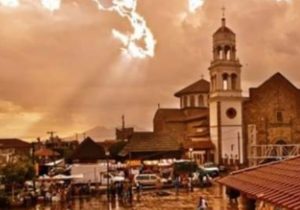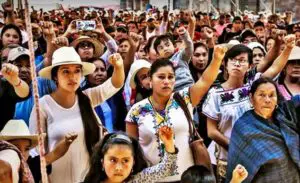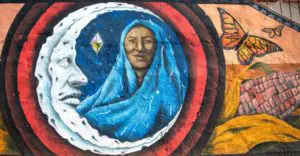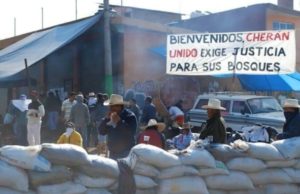Podcast: Play in new window | Download
Subscribe: Apple Podcasts | RSS
 April 15, 2011 was a historic day for the town of Cherán, located in the northern mountainous area of the Mexican state of Michoacán. Known as El Gran Levantamiento, or “The Great Uprising,” what happened that day would not only impact this remote region of Mexico, but it would also serve as an example for indigenous sovereignty throughout the hemisphere. News footage showed women in traditional Purépecha shawls – grandmas, aunts and mothers – taking hammers to trucks while other angry Cherán residents rounded up people with the ferocity of a determined lynch mob. This uprising, while somewhat spontaneous on that spring day, was in the making for many years. The people of this peaceful indigenous community had had enough, and April 15 was the day they decided to do something about it.
April 15, 2011 was a historic day for the town of Cherán, located in the northern mountainous area of the Mexican state of Michoacán. Known as El Gran Levantamiento, or “The Great Uprising,” what happened that day would not only impact this remote region of Mexico, but it would also serve as an example for indigenous sovereignty throughout the hemisphere. News footage showed women in traditional Purépecha shawls – grandmas, aunts and mothers – taking hammers to trucks while other angry Cherán residents rounded up people with the ferocity of a determined lynch mob. This uprising, while somewhat spontaneous on that spring day, was in the making for many years. The people of this peaceful indigenous community had had enough, and April 15 was the day they decided to do something about it.
The Purépecha people, also known as the Tarascans, in English, have lived in west central Mexico for well over a thousand years. Their language is an isolate and their culture unique, two things that have baffled anthropologists and other researchers for many years. The Tarascans were the first in Mexico to work with metal, and this, together with other elements of their culture, lead some to believe that these people originally migrated from South America, either overland or by boats skirting the Pacific coast. By the time the Spanish arrived in Mexico in the early 1500s, the Tarascans had a formidable empire that the Aztecs would not dare try to conquer. The Tarascan State was comprised of many different ethnicities across a wide geographical area, but most of the people within this state were ethnically Purépecha. After the Spanish Conquest of the Tarascan State in the early decades of the 1500s, the Purépecha people retained most of their language and culture. This was more pronounced in the more rural areas of Michoacán. Incidentally, the name “Cherán” in the Purépecha language means, “A Place of Fear.” Some say this really means, “A place where the people are to be feared.”
 In the days, months and years leading up to the April 15, 2011, insurrection, the town of Cherán had been on what seemed to be the losing side of a long struggle against criminal activity and government corruption. Cherán is both the name of a municipio within the state of Michoacán and the name of a town. A Mexican municipio is roughly equivalent to a county in the United States. The town sits at over 7,000 feet in elevation and is surrounded by old pine and oak forests, 17,000 hectares of which are considered communal property and are managed by the residents of Cherán. Population statistics of this place vary. Official estimates state that around 20,000 people, almost all of whom are indigenous, live in the municipio, with most of them living in the town of Cherán. After the April 15th uprising, many news outlets, from major print sources to small internet blogs, were filled with sensationalized and “woke” headlines claiming that a small band of powerful Native women beat back the cartels. The whole situation was broader and more nuanced than that.
In the days, months and years leading up to the April 15, 2011, insurrection, the town of Cherán had been on what seemed to be the losing side of a long struggle against criminal activity and government corruption. Cherán is both the name of a municipio within the state of Michoacán and the name of a town. A Mexican municipio is roughly equivalent to a county in the United States. The town sits at over 7,000 feet in elevation and is surrounded by old pine and oak forests, 17,000 hectares of which are considered communal property and are managed by the residents of Cherán. Population statistics of this place vary. Official estimates state that around 20,000 people, almost all of whom are indigenous, live in the municipio, with most of them living in the town of Cherán. After the April 15th uprising, many news outlets, from major print sources to small internet blogs, were filled with sensationalized and “woke” headlines claiming that a small band of powerful Native women beat back the cartels. The whole situation was broader and more nuanced than that.
Before the defining event the people of the town had felt powerless in the face of illegal logging. The illegal loggers are called talamontes by the locals, and for years these individuals cut down the old growth forest of the municipio and carted the lumber to sawmills elsewhere, paying nothing to the people of Cherán. Huge trucks would thunder through town, using Cherán’s main road as part of their transport route. Some estimates put the traffic at 200 vehicles per day. No one knows exactly who these trucks belonged to, but they obviously were a part of a highly organized criminal operation. Some say that the illegal logging was a side business of the drug cartels, but this cannot be confirmed. Along with the illegal logging came many other associated criminal activities, including kidnapping and murder. In fact, two members of the town committee charged with monitoring forest activity were kidnapped while on patrol on February 11, 2011, never to be seen again. Many of the residents of Cherán often got caught in the middle as unintended victims of criminal violence. People in the town repeatedly turned to local municipal authorities in desperation, but politicians and law enforcement throughout the municipio were paid off handsomely by the criminal elements operating in the region. So, to the people of Cherán, there was no official recourse for their long list of grievances.
 The day before the fateful day of the uprising a group of women went into the forest to try to reason with the talamontes. They were concerned that the illegal loggers were felling trees too close to an important natural spring. They knew that without the old trees the spring would produce less water and some people in the town needed the outflow of that spring to water their animals. The loggers wanted nothing to do with these women, so they verbally abused them, threatened them and chased them away. That was the last straw.
The day before the fateful day of the uprising a group of women went into the forest to try to reason with the talamontes. They were concerned that the illegal loggers were felling trees too close to an important natural spring. They knew that without the old trees the spring would produce less water and some people in the town needed the outflow of that spring to water their animals. The loggers wanted nothing to do with these women, so they verbally abused them, threatened them and chased them away. That was the last straw.
In the early morning hours of Friday, April 15, 2011, the church bells rang and people in the town lit off fireworks to indicate that there was danger. The townsfolk woke up, gathered together and formulated a plan. They blockaded a road leading from the forest and when the first illegal logging truck came through, an angry mob stopped it and took the talamontes hostage. The women used their traditional Purépecha rebozos, or shawls, to tie up the hostages. Many in the angry mob wanted to string up the criminals from an ancient tree just outside the church, but cooler heads prevailed that morning. As the danger was constant and very real, the church bells continued to chime, and the crowds grew. Almost the entire population of the town emerged from their homes to take part in the struggle, armed not only with firearms but with machetes, hammers and anything they could use to fight with. When the Cherán police mobilized to try to take care of the situation, they were run out of town by the angry mob who knew they would side with the loggers. Local politicians, from the mayor of Cherán on down, were told to get out of town as well, and they did. The rest of the morning some 200 people dug ditches and put up blockades to restrict access to the town of Cherán and the forest beyond. By the afternoon the town had organized a militia and started patrolling the perimeter of Cherán after establishing a series of checkpoints on the 3 main roads into town. The original hostages taken in the early morning were held until the end of the day, but only after the illegal loggers assured the town militia that they would never come back. As night fell, the newly organized Cherán defense force burned tires in the ditches made across the access roads. Carefully tended bonfires at strategic locations also kept any trespassers off the paths to the communal forest lands. Before the last of the illegal loggers left, the people of Cherán captured 7 of their vehicles and burned them. By the early evening, the people of Cherán were in complete control over their town and their thousands of acres of precious forest.
In the ensuing days, the police and politicians tried to come back and restore some semblance of what was, but the townsfolk would not let them back into Cherán. Over the next few weeks, with legal counsel, the Purépecha people of this tiny corner of Mchoacán invoked a little-used clause in the Mexican Constitution that permitted limited self-rule and autonomy for wholly indigenous communities. The people of Cherán would decide what was best for their future, and for this, they turned to their past.
 The system of self-rule is largely based on how communities in the old Tarascan Empire were governed. The people of Cherán organized their government into what political scientists would call a form of “direct democracy.” Cherán’s main governing body is a council of 12 called the “K’eri Jánaskakua,” whose members are elected from the town’s 4 neighborhoods. Elected officials and issues to be discussed at the council level are first discussed at the neighborhood level in the form of fogatas, or “community fires,” comprised of as few as 6 people per fogata. There are currently about 180 of these small neighborhood gatherings throughout Cherán. In addition to the main Council of 12, there is also an Elders Council, or Consejo de Keris that serves to advise that main council. Other representative bodies serving as advisory boards include a women’s council, a youth council, and a council focused on business development. Cherán does not send political representatives to the state or national levels. In fact, all political campaigning is outlawed in Cherán. Even if a car tries to enter the town with a political sticker on its windshield or bumper, it is removed by the Cherán security force at the checkpoints. If a Cherán resident wants to vote in a state or national election, they must do so at a polling place in another town specially designated for Cherán residents. In the years since the uprising, the town has maintained this internal structure of government. Almost like magic, the murders, kidnappings and other violent crimes have ground to a halt. The town still has petty crime such as public intoxication or minor thefts, but the rule breakers are given strictly supervised community service to pay for their wrongdoings.
The system of self-rule is largely based on how communities in the old Tarascan Empire were governed. The people of Cherán organized their government into what political scientists would call a form of “direct democracy.” Cherán’s main governing body is a council of 12 called the “K’eri Jánaskakua,” whose members are elected from the town’s 4 neighborhoods. Elected officials and issues to be discussed at the council level are first discussed at the neighborhood level in the form of fogatas, or “community fires,” comprised of as few as 6 people per fogata. There are currently about 180 of these small neighborhood gatherings throughout Cherán. In addition to the main Council of 12, there is also an Elders Council, or Consejo de Keris that serves to advise that main council. Other representative bodies serving as advisory boards include a women’s council, a youth council, and a council focused on business development. Cherán does not send political representatives to the state or national levels. In fact, all political campaigning is outlawed in Cherán. Even if a car tries to enter the town with a political sticker on its windshield or bumper, it is removed by the Cherán security force at the checkpoints. If a Cherán resident wants to vote in a state or national election, they must do so at a polling place in another town specially designated for Cherán residents. In the years since the uprising, the town has maintained this internal structure of government. Almost like magic, the murders, kidnappings and other violent crimes have ground to a halt. The town still has petty crime such as public intoxication or minor thefts, but the rule breakers are given strictly supervised community service to pay for their wrongdoings.
The municipio of Cherán still receives state and federal aid totaling a little over $2.5 million per year. However, this indigenous autonomous zone is almost completely independent and would likely survive on its own without state and federal monies. Half of the town’s economy is based on agriculture and livestock. Most families have animals, and cows, horses, pigs, chickens, sheep and goats are raised mostly for local use. In addition to small home gardens which provide a multitude of different fruits and vegetables for home use and to trade in the local market, many acres in and around Cherán are dedicated to larger-scale agriculture. The people here enjoy a bounty of corn, wheat, potatoes, beans and oats. Commercial orchards produce apples, pears, plumbs and peaches. The people of Cherán engage in responsible logging and not only do they sell the lumber to buyers outside of town, the wood is used in the town’s furniture-making workshops and is transformed into beautiful but practical pieces that are exported to places beyond Michoacán. Some 3,000 acres of forest have been replanted with the help of a tree nursery constructed right after the uprising. Cherán has modern medical doctors, but since gaining its autonomy native healers have risen in prominence and the town now has an ample amount of traditional Purépecha medical practitioners. A locally run radio station broadcasts to the surrounding area in the Purépecha language. All of these advances and improvements aside, if you ask anyone on the streets of Cherán what they think of all of this, they will tell you that they are much happier and safer, and feel more prosperous under the autonomous system.
What was once looked at by the rest of Mexico as a curious experiment, the town of Cherán has flourished under self-rule. Other indigenous communities have since tried the same self-government model, and there is a word in Spanish, Cheranizar, which literally means “to Cheránize” or “to become like Cherán.” With such a stellar example of indigenous autonomy it will not be surprising that many other native communities throughout Mexico will try something similar and will most likely meet with similar successes.
REFERENCES
Beals, Ralph L. Cheran: A Sierra Tarascan Village. Oklahoma City, University of Oklahoma Press, 1973. We are an Amazon affiliate. Buy the book on Amazon here: https://amzn.to/3zoPN55
McDonnell, Patrick J. “One Mexican Town Revolts Against Violence and Corruption. Six Years in, its Experiment is Working.” Los Angeles Times, 10 Jul 2017.
Pressly, Linda. “Cheran: The Town that Threw Out the Police, Politicians and Gangsters.” BBC News, 13 Oct 2016.
